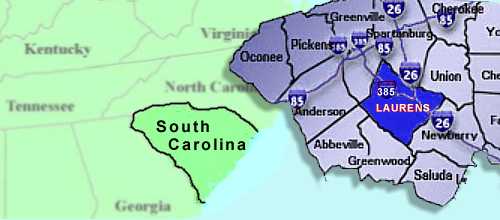 Native
Americans, or American Indians, were the first known inhabitants of the
area now known as Laurens County. The Cherokee Indians, members of the
Iroquois nation, lived and hunted in the western and central piedmont of
South Carolina. Many Indian artifacts have been unearthed in the areas
along the Enoree River, Bush River, and Rabon Creek. William MacPherson
settled on Rabon Creek, in the late 1700’s with his family. Pioneers
to the western piedmont area of the Carolinas came down through the
backcountry of Pennsylvania, Maryland and Virginia
then through North Carolina on
to the South Carolina are. These people were the Scotch Irish. The
first known white settler to arrive in what is now Laurens County was John
Duncan in 1753. From Aberdeen, Scotland, Duncan spent a few years in
Pennsylvania before moving south. He liked the lush vegetation and
abundant wildlife he found in this area and settled around a creek in the
northeastern section of the county not far from the present city of
Clinton. John Duncan built a rustic house, a few outbuildings, a
distillery, and organized a church. He brought the first African slave and
the first horse-drawn wagon into the area. Of course, the creek near which
he settled is known today as Duncan's Creek, and the church, still in
existence, is the Duncan's Creek Presbyterian Church, the oldest church in
Laurens County and one of the oldest Presbyterian Churches in the
backcountry Native
Americans, or American Indians, were the first known inhabitants of the
area now known as Laurens County. The Cherokee Indians, members of the
Iroquois nation, lived and hunted in the western and central piedmont of
South Carolina. Many Indian artifacts have been unearthed in the areas
along the Enoree River, Bush River, and Rabon Creek. William MacPherson
settled on Rabon Creek, in the late 1700’s with his family. Pioneers
to the western piedmont area of the Carolinas came down through the
backcountry of Pennsylvania, Maryland and Virginia
then through North Carolina on
to the South Carolina are. These people were the Scotch Irish. The
first known white settler to arrive in what is now Laurens County was John
Duncan in 1753. From Aberdeen, Scotland, Duncan spent a few years in
Pennsylvania before moving south. He liked the lush vegetation and
abundant wildlife he found in this area and settled around a creek in the
northeastern section of the county not far from the present city of
Clinton. John Duncan built a rustic house, a few outbuildings, a
distillery, and organized a church. He brought the first African slave and
the first horse-drawn wagon into the area. Of course, the creek near which
he settled is known today as Duncan's Creek, and the church, still in
existence, is the Duncan's Creek Presbyterian Church, the oldest church in
Laurens County and one of the oldest Presbyterian Churches in the
backcountry
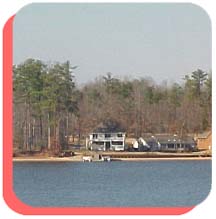 It
is difficult to locate exact spots in the county where Revolutionary War
military skirmishes took place. Important ones recorded include those at
Lindley's Fort, the Battle of Musgrove's Mill on the Enoree River, and
Hayes Station. It
is difficult to locate exact spots in the county where Revolutionary War
military skirmishes took place. Important ones recorded include those at
Lindley's Fort, the Battle of Musgrove's Mill on the Enoree River, and
Hayes Station.
Part of the old Ninety-Six district,
Laurens became a separate county in 1785 being named for the Revolutionary
War era patriot Henry Laurens of Charleston. The town of Laurens (known as
Laurensville well into the nineteenth century) became the county seat, and
the first courthouse was erected in 1786. The current courthouse was built
in 1840 and enlarged in 1857. By 1820, the town had become known for its
trade of tailor-made clothes. Andrew Johnson, a future president of the
United States, and his brother came to Laurens in 1824 and established a
tailor shop.
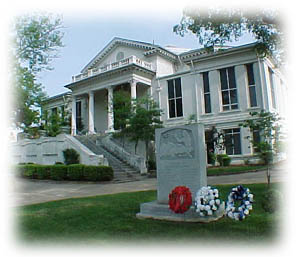 By
1840, Laurens was booming with establishments including medical
practitioners, a fancy confectionery and fruit store, carriage, buggy, and
wagon shops, tailoring establishments, building contractors, flour and
corn mills, and eighty-one registered whiskey distilleries. By
1840, Laurens was booming with establishments including medical
practitioners, a fancy confectionery and fruit store, carriage, buggy, and
wagon shops, tailoring establishments, building contractors, flour and
corn mills, and eighty-one registered whiskey distilleries.
The 1888 BUSINESS DIRECTORY OF LAURENS
stated that with the rapid growth of the city and with the excellent
railroad connections, "Laurens can well be termed the Atlanta of
South Carolina".
The town of Clinton, named for local
attorney and representative to the South Carolina Legislature Henry
Clinton Young, built up around Holland's Store which in 1809 housed the
only post office in the eastern part of Laurens County.
In 1864, William Plumer Jacobs, a young
minister, came to Clinton and found "a mud hole surrounded by
barrooms". He crusaded for temperance, and the bricks from the last
barroom to be demolished were used to build a chimney for Jacobs' new home
on South Broad Street. Dr. Jacobs is one of the most prominent men in the
history of Laurens County in that both Presbyterian College and Thornwell
Home and School are products of his vision and effort.
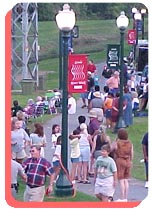 No
military action occurred in Laurens County during the Civil War though
many native sons who went off to war became casualties of the conflict. No
military action occurred in Laurens County during the Civil War though
many native sons who went off to war became casualties of the conflict.
Cotton became an import crop in Laurens
County with the invention of the cotton gin. Along with the expansion of
cotton came the expansion of slavery. The number of slaves grew from 1,919
in 1800 to more than 13,000 in 1860. The desire to grow more and more
cotton depleted forests as land was cleared, and poor agricultural
practices depleted the fertileness of the soil.
By the end of the nineteenth century,
textiles were becoming very important in Laurens County and the upstate.
The Laurens Cotton Mill was established in 1895, Mercer Silas Bailey built
the first cotton mill in Clinton in 1896, and the year 1902 saw the
establishment of both Lydia Mill and Watts Mill.
The means of transportation over the years
has caused life in the county to change. With the building of railroads in
the last half of the nineteen century, the towns and communities of Cross
Hill, Mountville, Waterloo, Ora, and Lanford grew. But, with the advent of
the automobile and the construction of roads in the twentieth century,
these areas lost vitality. Even today, our interstate highways make people
very mobile causing local merchants and service providers to lose business
to surrounding larger communities.
LAURENS
COUNTY INFORMATION & HISTORY
-
ORIGIN OF NAME:
Laurens County is named for the South Carolina patriot from Charleston,
Henry Laurens. For a time, Laurens was President of the Continental
Congress during the Revolutionary War. He was captured by the British
while on his way to Europe to gain support for the colonies' cause, was
imprisoned in the Tower of London, and, after his release at the end of
the war, was sent to Paris to help negotiate the peace.
-
POPULATION:
1990 CENSUS: 58,092 1995 ESTIMATE: 60,800
-
AREA:
713 Square Miles
-
CLIMATE:
Temperate, with a mean annual temperature of 61.5 degrees F. Average
seasonal temperatures are: January, 43.2; July, 79.5. Average daily
relative humidity: 75% at 1 AM; 79% at 7 AM; 51% at 1 PM; and 60% at 7
PM. The mean annual precipitation is 47 inches, and the average growing
season is 229 days.
-
PRINCIPAL GEOGRAPHIC
FEATURES:
Laurens County is relatively level in its eastern and southern portions,
with rolling, wooded hills dominating the northern and western sections.
Located in the Piedmont area of the state, it is bounded on the
northeast side by the Enoree River, and by Lake Greenwood and the Saluda
River on the southwest side. Counties adjoining Laurens are: Abbeville,
Greenville, Greenwood, Newberry, Spartanburg, and Union. Laurens County
lies between the 34th and 35th parallels of latitude, and the 82nd
meridian of longitude passes near the center of the county. The
elevation of the highest point in the county is 751 feet and the lowest
point 400 feet. The elevation of the county seat, Laurens is 589 feet.
-
COUNTY SEAT:
Laurens.
-
MAJOR TOWNS WITH 1990
POPULATIONS:
Clinton - 7,987 Laurens - 9,694
-
PRINCIPAL INDUSTRIES AND
AGRICULTURE:
Industries: Textiles, plastics, metal bearings, ceramics, cardboard
containers, pipes and commercial valves, printing, automotive parts and
supplies, and warehouse distribution centers. Agriculture: Timber,
cattle, soybean, pork, poultry, apples, peaches, and grain.
-
EDUCATION:
Presbyterian College, founded in 1880 and located in Clinton, is a
coeducational, liberal arts college with an enrollment of approximately
1,100. For several years, US NEWS & WORLD REPORT has listed PC as
one of the top small colleges in the nation. In addition to its
excellent academic reputation and well-rounded sports program, the
college is a key cultural and entertainment resource for Laurens County.
Thornwell Home and School in Clinton, founded in 1875, is widely known
for the cottage plan it pioneered. A beautiful campus of stone
buildings, many trees, and landscaping with roses and azaleas, the
School division provides the area with the opportunity for private
education, grades K-12. The institution is owned and controlled by the
Presbyterian Synods of South Carolina, Georgia, and Florida. Whitten
Center, founded in 1918, is a state institution for the mentally
retarded. The institution is located in the City of Clinton. The Laurens
County Library operates a 23,000 square-foot Headquarters Facility in
Laurens, a full-service branch in Clinton, and a small branch in Joanna.
There is a bookmobile, and deposits of large-type books are maintained
at residential facilities for senior citizens. The library system has
110,000 volumes and maintains an extensive local history and genealogy
collection in the Laurens Library.
-
RECREATION:
For recreation, excellent YMCA facilities with indoor swimming pools,
tennis courts, health clubs, weight and workout rooms, craft rooms, and
handball and racquetball courts are located in modern, up-to-date
facilities in both Clinton and Laurens. The cities of Laurens and
Clinton and Laurens County operate parks with tennis courts, baseball
and softball fields, and other recreational facilities. Lake Greenwood
is an excellent recreational resource, and Lake Rabon, a county water
reservoir, provides water recreational opportunities including limited
boating. There are three golf courses in the county, and the Sumter
National Forest provides public hunting and hiking areas.
-
HISTORIC SITES:
The James Dunklin House in Laurens, built in 1812, is an outstanding
example of "up-country architecture of the Federal period". It
is open to the public. Duncan's Creek Presbyterian Church is the oldest
church organization in the upper part of the state. Founded in 1753, the
current building, located off Highway 72 a few miles northeast of
Clinton, was erected in 1842. The Episcopal Church of the Epiphany in
Laurens, erected in 1846, is the oldest church building still in use in
the City of Laurens. The Home of Peace at Thornwell Home and School,
Clinton, was erected in 1874 and was the first building of the
institution. Today, it is a museum. The Duckett House in Laurens was the
home of Charles H. Duckett, a prominent black businessman who died in
1947 at the age of 87. For many years, he was the only African- American
in the Southeast operating a retail lumber business. Efforts are
underway to restore this home located in Laurens. The Laurens County
Courthouse was built 1835-1840. It was enlarged and remodeled in 1911.
Located in the Public Square in Laurens, it is of the Greek Revival
style.
-
HISTORY:
Laurens County is a part of the original Ninety Six District. In 1785,
nine years after Independence, the General Assembly passed an act
creating six counties (Laurens, Newberry, Abbeville, Edgefield,
Spartanburg, and Union) from the District. The county was settled by
Scotch Irish with many of their descendants still residing in the area.
After the county was created, a nucleus of a town was started as the
county seat. Eventually to become known as Laurens, a charter was issued
for Laurensville in December 1845. The first record of the town being
officially called Laurens appears on a charter issued in 1873. The other
major city of the county, Clinton, grew up eight miles east of the
county seat. The settlement started at the intersection of the main
roads between Greenville and Columbia, and Spartanburg and Augusta.
Named for Laurensville lawyer Henry Clinton Young who helped lay out the
first streets, Clinton was first granted a charter in 1852. Dr. William
P. Jacobs moved to Clinton in 1864, and he was responsible for the
formation of Thornwell Orphanage and Presbyterian College in the town.
The 1890's saw the town being served by two railroads and the growth of
the community boomed. During the early 1900's, the county became a large
textile center with several major cotton mills being constructed in
Laurens, Clinton, and Joanna. More recently, as dependence on cotton
declined, industry and agriculture has diversified. The 1970's brought
little industrial development to the county, but since 1980, several new
industries and distribution centers have located here.
-
IMPORTANT PEOPLE:
Anne Pamela Cunningham of Laurens County organized the movement for the
acquisition and restoration of Mount Vernon, the home of George
Washington. She is entitled to the full credit for the preservation of
this home of our country's first president as a national shrine. She is
a member of the South Carolina Hall of Fame. Charles H. Duckett was a
prominent black farmer, carpenter, contractor, and funeral home
proprietor and for many years was the only African-American in the
Southeast operating a retail lumber business. Dr. Wil Lou Gray initiated
a program of adult, night education in the Young's community of Laurens
County. Her program was adopted on a state-wide basis, and she became
recognized nationally as an effective leader in the campaign against
illiteracy. She is a member of the South Carolina Hall of Fame. Henry
McDaniel, a noted Black politician from Laurens County, served in the
South Carolina Legislature from 1868 until 1872. He proposed several
bills to in- corporate churches throughout the county and was
responsible for getting several roads established. Admiral Sam McGowan
served as Paymaster General of the Navy during World War I and, after
his retirement, served as Chief Highway Commissioner for the State of
South Carolina. Thomas Sanders, 1860-1945, was an educator and
humanitarian. His parents had been slaves, but he obtained an education
and came to Laurens in 1895 to teach. Sander's achievements included
bringing education for Laurens' black citizens from almost nothing to a
very organized system. Well respected, one of the public schools in
Laurens today bears his name. Sanders was featured in Ripley's
"Believe It or Not" for not missing a day of school for 53
years. Pratt S. Suber, 1843-1929, was a former slave who became Laurens
County's first county school Commissioner of Education when the office
was established in 1871. Suber also served Laurens County in the South
Carolina House of Representatives. From 1874 until 1876, he served as
the first county Superintendent of Education. Columbus White, 1857-1945,
was a leading contractor, architect, and builder. Two structures he
designed and built in the City of Laurens, Bethel AME Church and the
Brown-Franklin Building, are still standing and are on the National
Register of Historic Places. Two of South Carolina's governors have been
from Laurens County: Robert A. Cooper and William D. Simpson.
-
RETIREMENT INSTITUTIONS:
The Martha Franks Baptist Retirement Center, located in Laurens, is
operated by the South Carolina Baptist Church. The focal point of the
campus is the Villa, a home built in 1859 of the Italian villa style,
which houses offices and serves as a social center. Residential
facilities include individual cottages, patio homes, apartments,
dormitory rooms, and an eighty-eight bed skilled nursing unit. The
Presbyterian Home of South Carolina operates two campuses in Clinton.
The Clinton Home has cottages, apartments, rooms, and the sixty-six bed
Kerr-Johnson Infirmary. Frampton Hall is centrally located in town and
has apartments and rooms.
-
HEALTH CARE:
The Laurens County Hospital, constructed in 1989, is a modern,
well-equipped, all private room hospital. Approximately forty physicians
practice at the hospital, and specialties represented include family
medicine, internal medicine, pediatrics, obstetrics and gynecology,
general surgery, urology, orthopedics, ophthalmology, radiology,
emergency medicine, and anesthesiology
-
FOR FURTHER READING:
Jacobs, William P., ed. LAURENS COUNTY SCRAPBOOK. Laurens County
Historical Society, 1982. Bolick, Julian Stevenson. A LAURENS COUNTY
SKETCHBOOK, Clinton, S. C., Jacobs Press, 1973.
FOR FURTHER INFORMATION:
Laurens County Chamber of Commerce
P. O. Box 248
Laurens, S. C. 29360
Phone: 864-833-2716
Laurens County Historical Society
P. O. Box 292
Laurens, S. C. 29360 Below
are Historic Maps from 1853: on the left Laurensville and on the right
Waterloo.
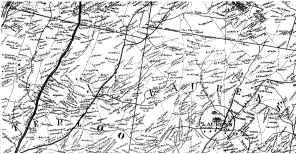 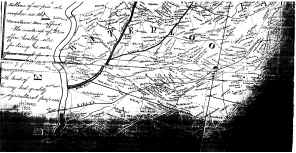
|

